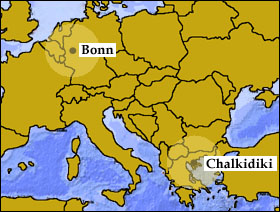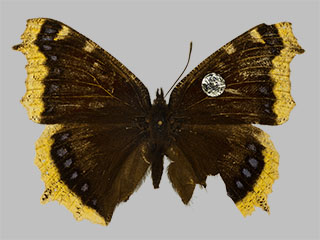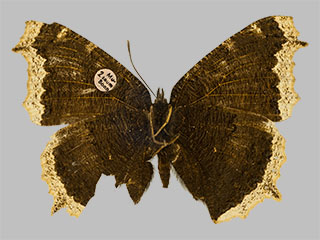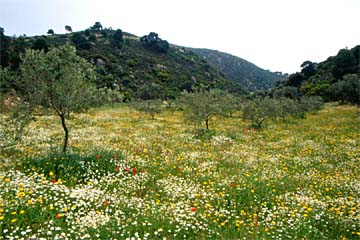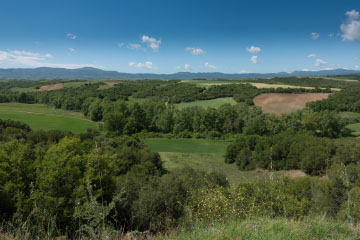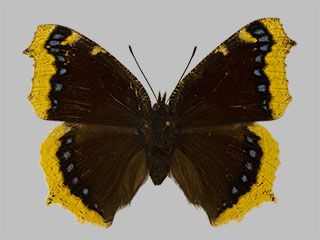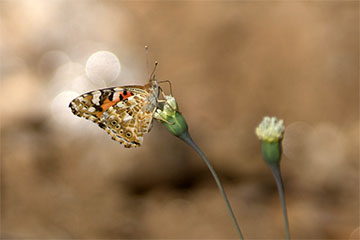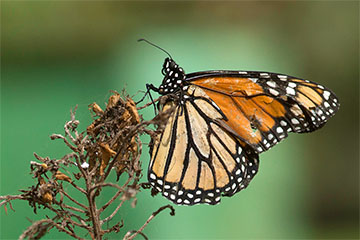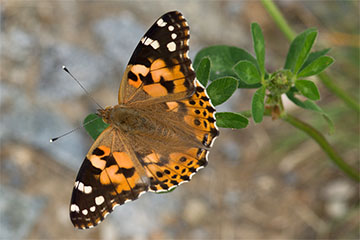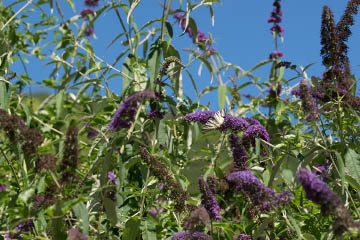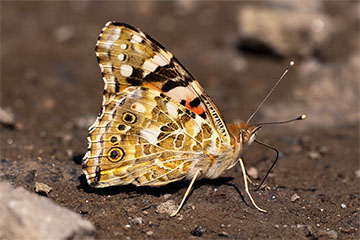To investigate the migration behaviour of the  Camberwell BeautyNymphalis antiopa (Linnaeus, 1758)Mourning CloakCamberwell Beauty, Hubert Roer (1926-2002)Hubert Roer carried out field trials in Bonn,
Camberwell BeautyNymphalis antiopa (Linnaeus, 1758)Mourning CloakCamberwell Beauty, Hubert Roer (1926-2002)Hubert Roer carried out field trials in Bonn,  GermanyBonn in 1962 and 1968 Roer, 1970 - Untersuchungen zum Migrationsverhalten des Trauermantels (Nymphalis antiopa L.) (Lep., Nymphalidae).
GermanyBonn in 1962 and 1968 Roer, 1970 - Untersuchungen zum Migrationsverhalten des Trauermantels (Nymphalis antiopa L.) (Lep., Nymphalidae).
The  Camberwell BeautyNymphalis antiopa (Linnaeus, 1758)Mourning CloakCamberwell Beauties were imported as caterpillars in the penultimate larval stage from the northern Greek peninsula Chalkidiki, Macedonia,
Camberwell BeautyNymphalis antiopa (Linnaeus, 1758)Mourning CloakCamberwell Beauties were imported as caterpillars in the penultimate larval stage from the northern Greek peninsula Chalkidiki, Macedonia,  GreeceChalkidiki, Macedonia,
GreeceChalkidiki, Macedonia,  GreeceMacedonia,
GreeceMacedonia,  Greece
Greece Greece and bred further in the Museum Alexander Koenig, Bonn. After hatching, the
Greece and bred further in the Museum Alexander Koenig, Bonn. After hatching, the  Camberwell BeautyNymphalis antiopa (Linnaeus, 1758)Mourning CloakCamberwell Beauties were released a few kilometres southwest of Bonn,
Camberwell BeautyNymphalis antiopa (Linnaeus, 1758)Mourning CloakCamberwell Beauties were released a few kilometres southwest of Bonn,  GermanyBonn.
GermanyBonn.
To identify them, Hubert Roer (1926-2002)Hubert Roer signed them by sticking reflective dots (wing labels) on the wings before releasing them.

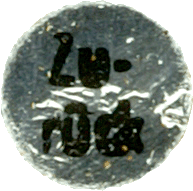
As in 1962 the weather conditions at and after the time of hatching prevented the  Camberwell BeautyNymphalis antiopa (Linnaeus, 1758)Mourning CloakCamberwell Beauties from flying for several weeks, they had to wait for their release without food during this time. As this did not appear to have any negative effects, a special experiment was carried out in the 1968 series of experiments with regard to this observation.
Camberwell BeautyNymphalis antiopa (Linnaeus, 1758)Mourning CloakCamberwell Beauties from flying for several weeks, they had to wait for their release without food during this time. As this did not appear to have any negative effects, a special experiment was carried out in the 1968 series of experiments with regard to this observation.
 Camberwell BeautyNymphalis antiopa (Linnaeus, 1758)Mourning CloakCamberwell Beauty
Camberwell BeautyNymphalis antiopa (Linnaeus, 1758)Mourning CloakCamberwell Beauty
Nymphalis antiopa ssp. antiopa (ex larva) with wing labelling
[Breeding image; 77 mm]
Studies on the migration behaviour of the Camberwell Beauty (Nymphalis antiopa), by Hubert Roer, Bonn. Recaptured experimental butterfly.
Collection: Museum Alexander Koenig, Bonn
Catching:
Hubert Roer (1926-2002)Hubert Roer leg.; Chalkidiki, Macedonia,  GreeceChalkidiki, Macedonia,
GreeceChalkidiki, Macedonia,  GreeceMacedonia,
GreeceMacedonia,  Greece
Greece Greece (1968)
Greece (1968)
Breeding:
Hubert Roer (1926-2002)Hubert Roer; Museum Alexander Koenig,  GermanyMuseum Alexander Koenig (Bonn, Museum Alexander Koenig,
GermanyMuseum Alexander Koenig (Bonn, Museum Alexander Koenig,  GermanyBonn),
GermanyBonn),  Germany
Germany Germany (June 1968)
Germany (June 1968)
 Camberwell BeautyNymphalis antiopa (Linnaeus, 1758)Mourning CloakCamberwell Beauty
Camberwell BeautyNymphalis antiopa (Linnaeus, 1758)Mourning CloakCamberwell Beauty
Nymphalis antiopa ssp. antiopa (ex larva) with wing labelling
[Breeding image; 77 mm]
Studies on the migration behaviour of the Camberwell Beauty (Nymphalis antiopa), by Hubert Roer, Bonn. Recaptured experimental butterfly.
Collection: Museum Alexander Koenig, Bonn
Catching:
Hubert Roer (1926-2002)Hubert Roer leg.; Chalkidiki, Macedonia,  GreeceChalkidiki, Macedonia,
GreeceChalkidiki, Macedonia,  GreeceMacedonia,
GreeceMacedonia,  Greece
Greece Greece (1968)
Greece (1968)
Breeding:
Hubert Roer (1926-2002)Hubert Roer; Museum Alexander Koenig,  GermanyMuseum Alexander Koenig (Bonn, Museum Alexander Koenig,
GermanyMuseum Alexander Koenig (Bonn, Museum Alexander Koenig,  GermanyBonn),
GermanyBonn),  Germany
Germany Germany (June 1968)
Germany (June 1968)
Of 868  Camberwell BeautyNymphalis antiopa (Linnaeus, 1758)Mourning CloakCamberwell Beauties released in 1962 (24/06, 08/07 and 10/07/1962), there were only 16 returns (= 1.85%). Apart from one site located 20 km to the south-west (March 1963), all other sites were less than 10 km from the release site and for the most part located to the north or north-east. 3 recoveries concerned
Camberwell BeautyNymphalis antiopa (Linnaeus, 1758)Mourning CloakCamberwell Beauties released in 1962 (24/06, 08/07 and 10/07/1962), there were only 16 returns (= 1.85%). Apart from one site located 20 km to the south-west (March 1963), all other sites were less than 10 km from the release site and for the most part located to the north or north-east. 3 recoveries concerned  Camberwell BeautyNymphalis antiopa (Linnaeus, 1758)Mourning CloakCamberwell Beauties that flew around and were captured in September/October.
Camberwell BeautyNymphalis antiopa (Linnaeus, 1758)Mourning CloakCamberwell Beauties that flew around and were captured in September/October.
Olives
In 1968, the weather conditions were better and similar to those on Chalkidiki, Macedonia,  GreeceChalkidiki.
GreeceChalkidiki.
Of the 1627  Camberwell BeautyNymphalis antiopa (Linnaeus, 1758)Mourning CloakCamberwell Beauties released on three different days, there were only 14 responses (= 0.86%).
Camberwell BeautyNymphalis antiopa (Linnaeus, 1758)Mourning CloakCamberwell Beauties released on three different days, there were only 14 responses (= 0.86%).
On the first day of release (14 June 1968) it was sunny and there was a southerly wind. Some of the  Camberwell BeautyNymphalis antiopa (Linnaeus, 1758)Mourning CloakCamberwell Beauties flew off directly with the wind. The first recoveries after 7 and 10 days reported
Camberwell BeautyNymphalis antiopa (Linnaeus, 1758)Mourning CloakCamberwell Beauties flew off directly with the wind. The first recoveries after 7 and 10 days reported  Camberwell BeautyNymphalis antiopa (Linnaeus, 1758)Mourning CloakCamberwell Beauties in summer diapause at a north-westerly distance of 18 and 31 km respectively.
Camberwell BeautyNymphalis antiopa (Linnaeus, 1758)Mourning CloakCamberwell Beauties in summer diapause at a north-westerly distance of 18 and 31 km respectively.
Landscape in Halkidiki
The second day of departure (21 June 1968) was much cooler and no direct migrations were observed on this day. But in the following days the weather improved again with a renewed southerly wind. The first two recoveries were reported after 3 and 8 days. The distance here was 18 and 75 km respectively, the direction of the finds was northwards and both  Camberwell BeautyNymphalis antiopa (Linnaeus, 1758)Mourning CloakCamberwell Beauties were in summer diapause in houses. 2 recoveries concerned
Camberwell BeautyNymphalis antiopa (Linnaeus, 1758)Mourning CloakCamberwell Beauties were in summer diapause in houses. 2 recoveries concerned  Camberwell BeautyNymphalis antiopa (Linnaeus, 1758)Mourning CloakCamberwell Beauties that flew around in September/October.
Camberwell BeautyNymphalis antiopa (Linnaeus, 1758)Mourning CloakCamberwell Beauties that flew around in September/October.
On the third day of departure (29 July 1968), 100  Camberwell BeautyNymphalis antiopa (Linnaeus, 1758)Mourning CloakCamberwell Beauties were released which had spent 6 weeks without food in a dark box at about 10 degrees Celsius after hatching. Here, 26 days later, they were found again only 5 kilometres to the east.
Camberwell BeautyNymphalis antiopa (Linnaeus, 1758)Mourning CloakCamberwell Beauties were released which had spent 6 weeks without food in a dark box at about 10 degrees Celsius after hatching. Here, 26 days later, they were found again only 5 kilometres to the east.
After analysing the recovered  Camberwell BeautyNymphalis antiopa (Linnaeus, 1758)Mourning CloakCamberwell Beauties, Hubert Roer (1926-2002)Hubert Roer came to the following results and conclusions:
Camberwell BeautyNymphalis antiopa (Linnaeus, 1758)Mourning CloakCamberwell Beauties, Hubert Roer (1926-2002)Hubert Roer came to the following results and conclusions:
- After leaving the chrysalis, the
 Camberwell BeautyNymphalis antiopa (Linnaeus, 1758)Mourning CloakCamberwell Beauties migrate in suitable flying weather.
Camberwell BeautyNymphalis antiopa (Linnaeus, 1758)Mourning CloakCamberwell Beauties migrate in suitable flying weather. - The
 Camberwell BeautyNymphalis antiopa (Linnaeus, 1758)Mourning CloakCamberwell Beauty migrates with the wind (downwind migration).
Camberwell BeautyNymphalis antiopa (Linnaeus, 1758)Mourning CloakCamberwell Beauty migrates with the wind (downwind migration). - Newly hatched
 Camberwell BeautyNymphalis antiopa (Linnaeus, 1758)Mourning CloakCamberwell Beauties do not need food at first.
Camberwell BeautyNymphalis antiopa (Linnaeus, 1758)Mourning CloakCamberwell Beauties do not need food at first. - The populations from Chalkidiki, Macedonia,
 GreeceChalkidiki take a summer diapause after completing their migration.
GreeceChalkidiki take a summer diapause after completing their migration. - Before hibernation, the
 Camberwell BeautyNymphalis antiopa (Linnaeus, 1758)Mourning CloakCamberwell Beauties become active again to build up a reserve stockpile.
Camberwell BeautyNymphalis antiopa (Linnaeus, 1758)Mourning CloakCamberwell Beauties become active again to build up a reserve stockpile. - A rapid recovery of the Central European populations is not to be expected, as the chances of an immigrant finding a native partner after successful overwintering, or of two immigrants finding each other, are very low.
 Camberwell BeautyNymphalis antiopa (Linnaeus, 1758)Mourning CloakCamberwell Beauty
Camberwell BeautyNymphalis antiopa (Linnaeus, 1758)Mourning CloakCamberwell Beauty
Nymphalis antiopa ssp. antiopa (ex larva)
[Breeding image; 72 mm]
Studies on the migration behaviour of the Camberwell Beauty (Nymphalis antiopa), by Hubert Roer, Bonn.
Collection: Museum Alexander Koenig, Bonn
Catching:
Hubert Roer (1926-2002)Hubert Roer leg.; Chalkidiki, Macedonia,  GreeceChalkidiki, Macedonia,
GreeceChalkidiki, Macedonia,  GreeceMacedonia,
GreeceMacedonia,  Greece
Greece Greece (1968)
Greece (1968)
Breeding:
Hubert Roer (1926-2002)Hubert Roer; Museum Alexander Koenig,  GermanyMuseum Alexander Koenig (Bonn, Museum Alexander Koenig,
GermanyMuseum Alexander Koenig (Bonn, Museum Alexander Koenig,  GermanyBonn),
GermanyBonn),  Germany
Germany Germany (June 1968)
Germany (June 1968)
The last conclusion has obviously been confirmed today, 57 years later...
The  Painted LadyVanessa cardui (Linnaeus, 1758)Cynthia carduiCosmopolitanPainted Lady has increasingly been the subject of migration research in recent years.
Painted LadyVanessa cardui (Linnaeus, 1758)Cynthia carduiCosmopolitanPainted Lady has increasingly been the subject of migration research in recent years.
Like the  Camberwell BeautyNymphalis antiopa (Linnaeus, 1758)Mourning CloakCamberwell Beauty, the
Camberwell BeautyNymphalis antiopa (Linnaeus, 1758)Mourning CloakCamberwell Beauty, the  Painted LadyVanessa cardui (Linnaeus, 1758)Cynthia carduiCosmopolitanPainted Lady is a migratory butterfly. The migratory behavior of the
Painted LadyVanessa cardui (Linnaeus, 1758)Cynthia carduiCosmopolitanPainted Lady is a migratory butterfly. The migratory behavior of the  Painted LadyVanessa cardui (Linnaeus, 1758)Cynthia carduiCosmopolitanPainted Lady is seasonally repetitive and takes place via more or less fixed routes, as is the case with many migratory birds.
Painted LadyVanessa cardui (Linnaeus, 1758)Cynthia carduiCosmopolitanPainted Lady is seasonally repetitive and takes place via more or less fixed routes, as is the case with many migratory birds.
In contrast to the  Camberwell BeautyNymphalis antiopa (Linnaeus, 1758)Mourning CloakCamberwell Beauty, however, the
Camberwell BeautyNymphalis antiopa (Linnaeus, 1758)Mourning CloakCamberwell Beauty, however, the  Painted LadyVanessa cardui (Linnaeus, 1758)Cynthia carduiCosmopolitanPainted Lady is usually common in Europe and can in principle be found in any location. The
Painted LadyVanessa cardui (Linnaeus, 1758)Cynthia carduiCosmopolitanPainted Lady is usually common in Europe and can in principle be found in any location. The  Painted LadyVanessa cardui (Linnaeus, 1758)Cynthia carduiCosmopolitanPainted Lady does not hibernate in summer or winter. It carries out an uninterrupted succession of generations with several generations per year. The food plants of the
Painted LadyVanessa cardui (Linnaeus, 1758)Cynthia carduiCosmopolitanPainted Lady does not hibernate in summer or winter. It carries out an uninterrupted succession of generations with several generations per year. The food plants of the  Painted LadyVanessa cardui (Linnaeus, 1758)Cynthia carduiCosmopolitanPainted Lady caterpillars (e.g. some thistle species, Stinging nettleUrtica dioicaStinging nettle) are widespread. The butterfly is adaptable and its breeding is comparatively simple:
Painted LadyVanessa cardui (Linnaeus, 1758)Cynthia carduiCosmopolitanPainted Lady caterpillars (e.g. some thistle species, Stinging nettleUrtica dioicaStinging nettle) are widespread. The butterfly is adaptable and its breeding is comparatively simple:  Painted LadyVanessa cardui (Linnaeus, 1758)Cynthia carduiCosmopolitanPainted Lady caterpillars can even be ordered via the Internet and obtained by post.
Painted LadyVanessa cardui (Linnaeus, 1758)Cynthia carduiCosmopolitanPainted Lady caterpillars can even be ordered via the Internet and obtained by post.
BBC-Program The Great Butterfly Adventure - Africa to Britain with the Painted Lady
 Painted LadyVanessa cardui (Linnaeus, 1758)Cynthia carduiCosmopolitanPainted Lady
Painted LadyVanessa cardui (Linnaeus, 1758)Cynthia carduiCosmopolitanPainted Lady
Painted Lady (Vanessa cardui) at Gamsberg-Pass in Namibia
While travelling along the Gamsberg Pass, I only saw a few butterflies here and there in the otherwise rather barren landscape. But then there were some flowering plants next to the road whose few flowers were full of sucking butterflies. The only butterfly I knew of from Europe was the Painted Lady (Vanessa cardui) I photographed.
In the 90-minute program The Great Butterfly Adventure - Africa to Britain with the Painted Lady, hosted by Martha KearneyMartha Kearney and James LoganJames Logan, the BBC reported on the  Painted LadyVanessa cardui (Linnaeus, 1758)Cynthia carduiCosmopolitanPainted Lady and its migratory behavior in beautiful pictures in autumn 2016.
Painted LadyVanessa cardui (Linnaeus, 1758)Cynthia carduiCosmopolitanPainted Lady and its migratory behavior in beautiful pictures in autumn 2016.
Most of the scenes in the program are set around the Rothamsted Research in Harpenden/Hertfordshire and in  Morocco
Morocco Morocco south of Marrakesch,
Morocco south of Marrakesch,  MoroccoMarrakesch between the Atlas Mountains and the Sahara.
MoroccoMarrakesch between the Atlas Mountains and the Sahara.
The core content of the program is essentially the academic work of migration specialists such as Constanti StefanescuConstanti Stefanescu from the Granollers Museum of Natural Sciences, Rebecca NesbitRebecca Nesbit and employees of Rothamsted Research.
 MonarchDanaus plexippus (Linnaeus, 1758)Monarch ButterflyMonarch
MonarchDanaus plexippus (Linnaeus, 1758)Monarch ButterflyMonarch
Monarch (Danaus plexippus) on a withered plant in Taoro Park in the urban area of Puerto de la Cruz, Tenerife
According to the BBC program, the  Painted LadyVanessa cardui (Linnaeus, 1758)Cynthia carduiCosmopolitanPainted Lady is the most widespread and longest migratory butterfly in the world. At up to 5,000 kilometers, the distance covered during migration is even greater than that of the
Painted LadyVanessa cardui (Linnaeus, 1758)Cynthia carduiCosmopolitanPainted Lady is the most widespread and longest migratory butterfly in the world. At up to 5,000 kilometers, the distance covered during migration is even greater than that of the  MonarchDanaus plexippus (Linnaeus, 1758)Monarch ButterflyMonarch.
MonarchDanaus plexippus (Linnaeus, 1758)Monarch ButterflyMonarch.  MonarchDanaus plexippus (Linnaeus, 1758)Monarch ButterflyMonarchs cover around 3,500 kilometers on their migration from northern America to
MonarchDanaus plexippus (Linnaeus, 1758)Monarch ButterflyMonarchs cover around 3,500 kilometers on their migration from northern America to  Mexico
Mexico Mexico. The 0.2 gram
Mexico. The 0.2 gram  Painted LadyVanessa cardui (Linnaeus, 1758)Cynthia carduiCosmopolitanPainted Lady flies at a maximum speed of 48 km/h (30 miles per hour). The females are usually larger and the color of their wings is paler than that of the males.
Painted LadyVanessa cardui (Linnaeus, 1758)Cynthia carduiCosmopolitanPainted Lady flies at a maximum speed of 48 km/h (30 miles per hour). The females are usually larger and the color of their wings is paler than that of the males.
The geographical origin of the butterflies migrating to Europe is North Africa. For  Painted LadyVanessa cardui (Linnaeus, 1758)Cynthia carduiCosmopolitanPainted Ladies from western and north-western Europe, this is
Painted LadyVanessa cardui (Linnaeus, 1758)Cynthia carduiCosmopolitanPainted Ladies from western and north-western Europe, this is  Morocco
Morocco Morocco. Butterflies from southern and south-eastern European areas (e.g.
Morocco. Butterflies from southern and south-eastern European areas (e.g.  Italy
Italy Italy,
Italy,  Greece
Greece Greece) migrate from areas east of
Greece) migrate from areas east of  Morocco
Morocco Morocco.
Morocco.
The  Painted LadyVanessa cardui (Linnaeus, 1758)Cynthia carduiCosmopolitanPainted Ladies spend the winter in North Africa. At the beginning of March, part of the butterfly generation that appears in
Painted LadyVanessa cardui (Linnaeus, 1758)Cynthia carduiCosmopolitanPainted Ladies spend the winter in North Africa. At the beginning of March, part of the butterfly generation that appears in  Morocco
Morocco Morocco leaves its birth area and migrates northwards over the Atlas Mountains, which are over 4000 meters high. The remaining butterflies remain in the area or migrate eastwards.
Morocco leaves its birth area and migrates northwards over the Atlas Mountains, which are over 4000 meters high. The remaining butterflies remain in the area or migrate eastwards.
The  Painted LadyVanessa cardui (Linnaeus, 1758)Cynthia carduiCosmopolitanPainted Ladies migrating to western Europe cross the Mediterranean and then prefer to settle in Catalonia,
Painted LadyVanessa cardui (Linnaeus, 1758)Cynthia carduiCosmopolitanPainted Ladies migrating to western Europe cross the Mediterranean and then prefer to settle in Catalonia,  SpainCatalonia,
SpainCatalonia,  Spain
Spain Spain, 1,500 kilometers away. They need between 20 and 36 hours for this with tailwind support. Some of the Catalan butterflies migrate further north, the remaining butterflies reproduce locally. The resulting new generation in turn remains partly in Catalonia,
Spain, 1,500 kilometers away. They need between 20 and 36 hours for this with tailwind support. Some of the Catalan butterflies migrate further north, the remaining butterflies reproduce locally. The resulting new generation in turn remains partly in Catalonia,  SpainCatalonia or moves further northwards. The procedure is repeated in the northern
SpainCatalonia or moves further northwards. The procedure is repeated in the northern  France
France France. Again, some of the butterflies move further northwards, e.g. to
France. Again, some of the butterflies move further northwards, e.g. to  United Kingdom (Great Britain)
United Kingdom (Great Britain) United Kingdom, where the procedure will be repeated from the beginning of May. In this way, some
United Kingdom, where the procedure will be repeated from the beginning of May. In this way, some  Painted LadyVanessa cardui (Linnaeus, 1758)Cynthia carduiCosmopolitanPainted Ladies reach regions around the Arctic Circle. Some
Painted LadyVanessa cardui (Linnaeus, 1758)Cynthia carduiCosmopolitanPainted Ladies reach regions around the Arctic Circle. Some  Painted LadyVanessa cardui (Linnaeus, 1758)Cynthia carduiCosmopolitanPainted Ladies - so-called pioneers - fly the entire route from
Painted LadyVanessa cardui (Linnaeus, 1758)Cynthia carduiCosmopolitanPainted Ladies - so-called pioneers - fly the entire route from  Morocco
Morocco Morocco to
Morocco to  United Kingdom (Great Britain)
United Kingdom (Great Britain) United Kingdom.
United Kingdom.
According to Richard FoxRichard Fox from Butterfly Conservation, some  Painted LadyVanessa cardui (Linnaeus, 1758)Cynthia carduiCosmopolitanPainted Ladies were sighted in
Painted LadyVanessa cardui (Linnaeus, 1758)Cynthia carduiCosmopolitanPainted Ladies were sighted in  United Kingdom (Great Britain)
United Kingdom (Great Britain) United Kingdom as early as January/February 2016, especially in the south-west
United Kingdom as early as January/February 2016, especially in the south-west  England
England England's. The butterflies originated in
England's. The butterflies originated in  Morocco
Morocco Morocco. The reasons for the early arrival of the butterflies were warm temperatures and southerly winds. It was not until June/July 2016 that mass migrations of
Morocco. The reasons for the early arrival of the butterflies were warm temperatures and southerly winds. It was not until June/July 2016 that mass migrations of  Painted LadyVanessa cardui (Linnaeus, 1758)Cynthia carduiCosmopolitanPainted Lady occurred in
Painted LadyVanessa cardui (Linnaeus, 1758)Cynthia carduiCosmopolitanPainted Lady occurred in  United Kingdom (Great Britain)
United Kingdom (Great Britain) United Kingdom. Poor weather conditions from March to May were the cause of the late arrival. In late October, the butterflies start their journey home to Africa.
United Kingdom. Poor weather conditions from March to May were the cause of the late arrival. In late October, the butterflies start their journey home to Africa.
 Painted LadyVanessa cardui (Linnaeus, 1758)Cynthia carduiCosmopolitanPainted Lady
Painted LadyVanessa cardui (Linnaeus, 1758)Cynthia carduiCosmopolitanPainted Lady
Painted Lady (Vanessa cardui) in Saxon Switzerland
In total, there are up to 6 generations of  Painted LadyVanessa cardui (Linnaeus, 1758)Cynthia carduiCosmopolitanPainted Ladies, which fly from
Painted LadyVanessa cardui (Linnaeus, 1758)Cynthia carduiCosmopolitanPainted Ladies, which fly from  Morocco
Morocco Morocco to the Arctic Circle and back to
Morocco to the Arctic Circle and back to  Morocco
Morocco Morocco.
Morocco.
Of the butterflies originally migrating eastwards from  Morocco
Morocco Morocco, some migrate in a similar way across the Mediterranean to
Morocco, some migrate in a similar way across the Mediterranean to  Italy
Italy Italy or
Italy or  Greece
Greece Greece. From these areas, some of the arriving butterflies and the butterflies of the newly formed generation migrate further northwards.
Greece. From these areas, some of the arriving butterflies and the butterflies of the newly formed generation migrate further northwards.
In 2016, the weather in May/June was unusually rainy, so that most  Painted LadyVanessa cardui (Linnaeus, 1758)Cynthia carduiCosmopolitanPainted Ladies in
Painted LadyVanessa cardui (Linnaeus, 1758)Cynthia carduiCosmopolitanPainted Ladies in  United Kingdom (Great Britain)
United Kingdom (Great Britain) United Kingdom only arrived late in late June or early July this year. They spread across practically the entire British Isles. The weather conditions further east were better in spring, resulting in many migrations in Corfu and Crete in May/June 2016.
United Kingdom only arrived late in late June or early July this year. They spread across practically the entire British Isles. The weather conditions further east were better in spring, resulting in many migrations in Corfu and Crete in May/June 2016.
Constanti StefanescuConstanti Stefanescu determined that in  Morocco
Morocco Morocco in spring, around 60-70% of all
Morocco in spring, around 60-70% of all  Painted LadyVanessa cardui (Linnaeus, 1758)Cynthia carduiCosmopolitanPainted Lady caterpillars are infested by larvae of the braconid wasp Cotesia vanessaeCotesia vanessae. Between 50 and 70 larvae (Organism that lives in close association with its host at the host's expense, eventually resulting in the death of the hostParasitoid larvae) develop in an infested caterpillar, causing the caterpillar to eventually die. The braconid wasps that hatch from the larvae are mostly female and can reproduce without male intervention by re-infesting
Painted LadyVanessa cardui (Linnaeus, 1758)Cynthia carduiCosmopolitanPainted Lady caterpillars are infested by larvae of the braconid wasp Cotesia vanessaeCotesia vanessae. Between 50 and 70 larvae (Organism that lives in close association with its host at the host's expense, eventually resulting in the death of the hostParasitoid larvae) develop in an infested caterpillar, causing the caterpillar to eventually die. The braconid wasps that hatch from the larvae are mostly female and can reproduce without male intervention by re-infesting  Painted LadyVanessa cardui (Linnaeus, 1758)Cynthia carduiCosmopolitanPainted Lady caterpillars. Constanti StefanescuConstanti Stefanescu concludes that the
Painted LadyVanessa cardui (Linnaeus, 1758)Cynthia carduiCosmopolitanPainted Lady caterpillars. Constanti StefanescuConstanti Stefanescu concludes that the  Painted LadyVanessa cardui (Linnaeus, 1758)Cynthia carduiCosmopolitanPainted Ladies migrating to Europe escape the Organism that lives in close association with its host at the host's expense, eventually resulting in the death of the hostParasitoid
Painted LadyVanessa cardui (Linnaeus, 1758)Cynthia carduiCosmopolitanPainted Ladies migrating to Europe escape the Organism that lives in close association with its host at the host's expense, eventually resulting in the death of the hostParasitoid  Morocco
Morocco Morocco through their migration.
Morocco through their migration.
 Scarce SwallowtailIphiclides podalirius (Linnaeus, 1758)Sail SwallowtailPear-Tree SwallowtailScarce Swallowtail
Scarce SwallowtailIphiclides podalirius (Linnaeus, 1758)Sail SwallowtailPear-Tree SwallowtailScarce Swallowtail
Orange Eye Butterflybush (Buddleja davidii) with a Scarce Swallowtail (Iphiclides podalirius) in the Ellerbach valley/Moselle
The oldest known specimen of a  Painted LadyVanessa cardui (Linnaeus, 1758)Cynthia carduiCosmopolitanPainted Ladies can be found - according to the BBC programme - in Natural History Museum, London under the care of Blanca HuertasBlanca Huertas: It is a dried butterfly from Hans Sloane (1660-1753)Hans Sloane, a scientist and insect collector. The
Painted LadyVanessa cardui (Linnaeus, 1758)Cynthia carduiCosmopolitanPainted Ladies can be found - according to the BBC programme - in Natural History Museum, London under the care of Blanca HuertasBlanca Huertas: It is a dried butterfly from Hans Sloane (1660-1753)Hans Sloane, a scientist and insect collector. The  Painted LadyVanessa cardui (Linnaeus, 1758)Cynthia carduiCosmopolitanPainted Lady is available in pressed form in a Collection of dried and pressed plants and plant parts.Herbarium from the botanist Adam Buddle (1662-1715)Adam Buddle. The Collection of dried and pressed plants and plant parts.Herbarium dates back to the late 17th century and the
Painted LadyVanessa cardui (Linnaeus, 1758)Cynthia carduiCosmopolitanPainted Lady is available in pressed form in a Collection of dried and pressed plants and plant parts.Herbarium from the botanist Adam Buddle (1662-1715)Adam Buddle. The Collection of dried and pressed plants and plant parts.Herbarium dates back to the late 17th century and the  Painted LadyVanessa cardui (Linnaeus, 1758)Cynthia carduiCosmopolitanPainted Lady already bears its English name, which is still used today: Painted Lady.
Painted LadyVanessa cardui (Linnaeus, 1758)Cynthia carduiCosmopolitanPainted Lady already bears its English name, which is still used today: Painted Lady.
Interesting: Carl von Linné (1707-1778)Carl von Linné named the Orange Eye ButterflybushBuddleja davidiiButterfly BushOrange Eye Butterflybush after Adam Buddle (1662-1715)Adam Buddle.
The Natural History Museum, London is home to the largest collection of  Painted LadyVanessa cardui (Linnaeus, 1758)Cynthia carduiCosmopolitanVanessa cardui in the world with around 3,000 specimens.
Painted LadyVanessa cardui (Linnaeus, 1758)Cynthia carduiCosmopolitanVanessa cardui in the world with around 3,000 specimens.
Rebecca NesbitRebecca Nesbit has experimentally discovered that  Painted LadyVanessa cardui (Linnaeus, 1758)Cynthia carduiCosmopolitanPainted Ladies orientate themselves by the position of the sun during their migration. It has not yet been conclusively clarified how the butterflies take into account the different positions of the sun depending on the day and season1. Rebecca NesbitRebecca Nesbit used a cylindrical barrel for her experiments, in which a butterfly attached to a wire can fly in a circle. In collaboration with Jason LimJason Lim from Rothamsted Research, the so-called Harmonic Radar was also used for the research. The radar has a maximum measuring range of around one kilometre. The
Painted LadyVanessa cardui (Linnaeus, 1758)Cynthia carduiCosmopolitanPainted Ladies orientate themselves by the position of the sun during their migration. It has not yet been conclusively clarified how the butterflies take into account the different positions of the sun depending on the day and season1. Rebecca NesbitRebecca Nesbit used a cylindrical barrel for her experiments, in which a butterfly attached to a wire can fly in a circle. In collaboration with Jason LimJason Lim from Rothamsted Research, the so-called Harmonic Radar was also used for the research. The radar has a maximum measuring range of around one kilometre. The  Painted LadyVanessa cardui (Linnaeus, 1758)Cynthia carduiCosmopolitanPainted Ladies are fitted with a small antenna on the chest and are thus visible to the radar every 3 seconds.
Painted LadyVanessa cardui (Linnaeus, 1758)Cynthia carduiCosmopolitanPainted Ladies are fitted with a small antenna on the chest and are thus visible to the radar every 3 seconds.
 Painted LadyVanessa cardui (Linnaeus, 1758)Cynthia carduiCosmopolitanPainted Lady
Painted LadyVanessa cardui (Linnaeus, 1758)Cynthia carduiCosmopolitanPainted Lady
Painted Lady (Vanessa cardui) near Klotten/Mosel
Jason ChapmanJason Chapman used a vertical-looking Entomological Radar to determine the altitude, speed and direction of migrating  Painted LadyVanessa cardui (Linnaeus, 1758)Cynthia carduiCosmopolitanPainted Ladies. The radar unit enables detection up to a height of 1.2 km. At this height, the diameter of the measuring range is 30 metres.
Painted LadyVanessa cardui (Linnaeus, 1758)Cynthia carduiCosmopolitanPainted Ladies. The radar unit enables detection up to a height of 1.2 km. At this height, the diameter of the measuring range is 30 metres.  Painted LadyVanessa cardui (Linnaeus, 1758)Cynthia carduiCosmopolitanPainted Ladies can be determined via a special typical pattern in the measurement result. Jason ChapmanJason Chapman has discovered in his measurements that
Painted LadyVanessa cardui (Linnaeus, 1758)Cynthia carduiCosmopolitanPainted Ladies can be determined via a special typical pattern in the measurement result. Jason ChapmanJason Chapman has discovered in his measurements that  Painted LadyVanessa cardui (Linnaeus, 1758)Cynthia carduiCosmopolitanPainted Ladies perform their migratory flight in a northerly direction up to an altitude of 1 kilometre. Jason ChapmanJason Chapman is also working on the question of how genes are responsible for migration tendencies. He suspects that environmental conditions such as weather or forage plant quality can activate migration genes. Some genes cause body fat to be converted into flight fuel. Other genes ensure well-developed, strong flight muscles, as can be seen in long-flyers. As the genes are differently developed in individual
Painted LadyVanessa cardui (Linnaeus, 1758)Cynthia carduiCosmopolitanPainted Ladies perform their migratory flight in a northerly direction up to an altitude of 1 kilometre. Jason ChapmanJason Chapman is also working on the question of how genes are responsible for migration tendencies. He suspects that environmental conditions such as weather or forage plant quality can activate migration genes. Some genes cause body fat to be converted into flight fuel. Other genes ensure well-developed, strong flight muscles, as can be seen in long-flyers. As the genes are differently developed in individual  Painted LadyVanessa cardui (Linnaeus, 1758)Cynthia carduiCosmopolitanPainted Lady individuals, there are some butterflies that migrate and others that do not.
Painted LadyVanessa cardui (Linnaeus, 1758)Cynthia carduiCosmopolitanPainted Lady individuals, there are some butterflies that migrate and others that do not.
In summary, the BBC programme gives the following reasons for the migration of  Painted LadyVanessa cardui (Linnaeus, 1758)Cynthia carduiCosmopolitanPainted Lady:
Painted LadyVanessa cardui (Linnaeus, 1758)Cynthia carduiCosmopolitanPainted Lady:
- Weather conditions
- Presence, quantity and quality of the food supply
- Genetic factors
- Organism that lives in close association with its host at the host's expense, eventually resulting in the death of the hostParasitoids
Despite some somewhat exaggerated statements, presumably due to the dramaturgy, and one or two didactically motivated repetitions, the BBC programme is very interesting and extremely worth seeing.
1Other butterflies have a so-called circadian clock in their antennae for this purpose.




